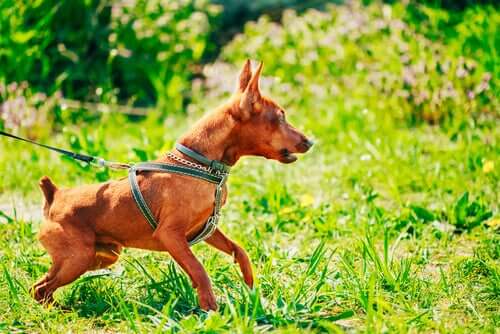How to Train Your Dog to Accept Handling


Written and verified by the lawyer Francisco María García
Many dogs radically change their behavior when they have to be handled. Trips to the vet become a nightmare for both these dogs and their owners. But if you train your dog to accept handling, things become less complicated.
Normally, dogs are the most affectionate animals in the world. That’s why millions of people invest in these pets. But some dogs may exhibit defensive behavior when they’re handled.
Contrary to what people believe, it isn’t that hard to improve an animal’s behavior. All you have to do is train your dog to coexist harmoniously with others.
Why do dogs become aggressive when they’re going to be handled?
There are many causes of aggressive behavior in dogs. You need to figure out the context in which the animal was violent. This way, you’ll understand what caused this negative behavior.

The most common cause of aggression is the feeling of possession of its owner and/or its territory. That explains why many dogs develop aggressive behaviors when another pet or member is included in the family unit.
Yes, it’s true that some breeds are more territorial than others. But it’s a myth that some breeds are just downright aggressive, while others are never violent. Any dog may react according to the stimuli it’s exposed to.
Innate temperament
We must mention that a moderate dose of aggressiveness is part of dogs’ instincts. Dogs descended from wolves. These animals find it essential to ensure the safety of their herd in a wild world. And they achieve that by safeguarding the territory and food around them.
But not allowing handling by a vet or groomer is a different story. What happens is that dogs consider these situations threatening, which is why they seek self-protection.
Every animal, including humans, feels fear of the unknown. Dogs are no exception. If visiting the vet or a groomer scares your dog, it may react aggressively or try to escape to defend itself.
Some factors can intensify the sensation of fear. The first factor is the dog’s breed and particular temperament. Some breeds are more distrustful and attentive to external stimuli. However, this can be improved with socialization.
Another important factor is the first time the animal is handled. It’s important to prepare your dog for their first vet visit. Exposing a dog to a radical change of environment can lead to aggressive reactions or further trauma.
How to train your dog to accept handling
Going to the vet, to a dog groomer, or to a canine hotel will require your dog to share their territory and experience new things. It’s essential to prepare them in advance to avoid any inconvenience.
Preventive socialization
The first step is to train your dog to socialize. The socialization process teaches your dog to interact peacefully with other animals and people, leading them to eventually accept handling. This process also greatly reduces the risk of aggressive behaviors and responses to external stimuli.
Ideally, your dog should socialize while it’s still a puppy, between the first 6-7 months of its life. But it’s also possible to train an adult dog to socialize by exposing them to contact with other dogs. It’s important to start introducing your dog to a single dog in a controlled environment. Then, you can gradually make your dog coexist with others.
Gradual exposure and adaptation
Any adaptation is a process. Your dog needs to get used to new stimuli. Before taking it directly to the vet, it’s advisable to adapt them beforehand by taking them out on walks and making them see other people and animals.
Prior to being handled, it’s important for your dog to adapt to the veterinary clinic’s new environment. Therefore, it’s recommended to take your dog to the vet clinic so it can get to know the place in a positive way.

Gradually, the environment will start becoming familiar to your dog, and its anxiety or fear will disappear.
Never force your dog to climb on the examination table. That may worsen their fear or cause trauma. Experts recommend encouraging your dog to play or giving it a treat while it’s at the vet. This way, they can associate going to the vet with something fun, not suffering.
Good practices
It’s important to trust pet care facilities. It’s always necessary to ensure that their practices are appropriate and they respect animal welfare. Thus, experts recommend looking for a trusted veterinarian and carefully choosing where to groom your furry friend.
Main picture source: Cristina Fernández and Romero
Many dogs radically change their behavior when they have to be handled. Trips to the vet become a nightmare for both these dogs and their owners. But if you train your dog to accept handling, things become less complicated.
Normally, dogs are the most affectionate animals in the world. That’s why millions of people invest in these pets. But some dogs may exhibit defensive behavior when they’re handled.
Contrary to what people believe, it isn’t that hard to improve an animal’s behavior. All you have to do is train your dog to coexist harmoniously with others.
Why do dogs become aggressive when they’re going to be handled?
There are many causes of aggressive behavior in dogs. You need to figure out the context in which the animal was violent. This way, you’ll understand what caused this negative behavior.

The most common cause of aggression is the feeling of possession of its owner and/or its territory. That explains why many dogs develop aggressive behaviors when another pet or member is included in the family unit.
Yes, it’s true that some breeds are more territorial than others. But it’s a myth that some breeds are just downright aggressive, while others are never violent. Any dog may react according to the stimuli it’s exposed to.
Innate temperament
We must mention that a moderate dose of aggressiveness is part of dogs’ instincts. Dogs descended from wolves. These animals find it essential to ensure the safety of their herd in a wild world. And they achieve that by safeguarding the territory and food around them.
But not allowing handling by a vet or groomer is a different story. What happens is that dogs consider these situations threatening, which is why they seek self-protection.
Every animal, including humans, feels fear of the unknown. Dogs are no exception. If visiting the vet or a groomer scares your dog, it may react aggressively or try to escape to defend itself.
Some factors can intensify the sensation of fear. The first factor is the dog’s breed and particular temperament. Some breeds are more distrustful and attentive to external stimuli. However, this can be improved with socialization.
Another important factor is the first time the animal is handled. It’s important to prepare your dog for their first vet visit. Exposing a dog to a radical change of environment can lead to aggressive reactions or further trauma.
How to train your dog to accept handling
Going to the vet, to a dog groomer, or to a canine hotel will require your dog to share their territory and experience new things. It’s essential to prepare them in advance to avoid any inconvenience.
Preventive socialization
The first step is to train your dog to socialize. The socialization process teaches your dog to interact peacefully with other animals and people, leading them to eventually accept handling. This process also greatly reduces the risk of aggressive behaviors and responses to external stimuli.
Ideally, your dog should socialize while it’s still a puppy, between the first 6-7 months of its life. But it’s also possible to train an adult dog to socialize by exposing them to contact with other dogs. It’s important to start introducing your dog to a single dog in a controlled environment. Then, you can gradually make your dog coexist with others.
Gradual exposure and adaptation
Any adaptation is a process. Your dog needs to get used to new stimuli. Before taking it directly to the vet, it’s advisable to adapt them beforehand by taking them out on walks and making them see other people and animals.
Prior to being handled, it’s important for your dog to adapt to the veterinary clinic’s new environment. Therefore, it’s recommended to take your dog to the vet clinic so it can get to know the place in a positive way.

Gradually, the environment will start becoming familiar to your dog, and its anxiety or fear will disappear.
Never force your dog to climb on the examination table. That may worsen their fear or cause trauma. Experts recommend encouraging your dog to play or giving it a treat while it’s at the vet. This way, they can associate going to the vet with something fun, not suffering.
Good practices
It’s important to trust pet care facilities. It’s always necessary to ensure that their practices are appropriate and they respect animal welfare. Thus, experts recommend looking for a trusted veterinarian and carefully choosing where to groom your furry friend.
Main picture source: Cristina Fernández and Romero
This text is provided for informational purposes only and does not replace consultation with a professional. If in doubt, consult your specialist.








